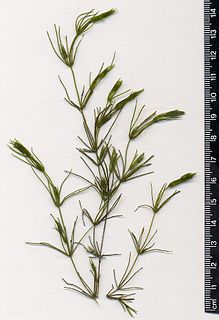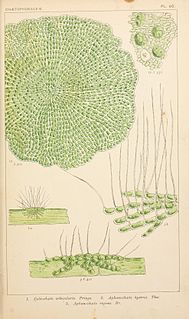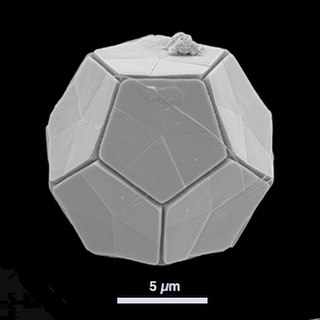
The glaucophytes, also known as glaucocystophytes or glaucocystids, are a small group of unicellular algae found in freshwater and moist terrestrial environments, less common today than they were during the Proterozoic. The stated number of species in the group varies from about 14 to 26. Together with the red algae (Rhodophyta) and the green algae plus land plants, they form the Archaeplastida. However, the relationships among the red algae, green algae and glaucophytes are unclear, in large part due to limited study of the glaucophytes.

Charales is an order of freshwater green algae in the division Charophyta, class Charophyceae, commonly known as stoneworts. Depending on the treatment of the genus Nitellopsis, living (extant) species are placed into either one family (Characeae) or two. Further families are used for fossil members of the order. Linnaeus established the genus Chara in 1753.

Receptaculites is the name-bearing genus for an extinct group of conspicuous benthic marine genera, the receptaculitids, that lived from the Early Ordovician through the Permian period, peaking in the Middle Ordovician. The group's phylogenetic origin has long been obscure, with some arguing that they were calcareous algae, probably of the order Dasycladales. Receptaculitids lived in warm, shallow seas, but consensus disagreeing. They have been described from all continents except Antarctica. In some areas they were important reef-formers, and they also occur as isolated specimens.
Tertiarius is a genus of freshwater diatoms known from the fossil record.

Caulerpaceae is a family of green algae in the order Bryopsidales.

Botryococcus is a genus of green algae. The cells form an irregularly shaped aggregate. Thin filaments connect the cells. The cell body is ovoid, 6 to 10 μm long, and 3 to 6 μm wide. Fossils of the genus are known since Precambrian times, and form the single largest biological contributor to crude oil, and are a major component of oil shales.

Hormotila is a genus of green algae in the family Chaetophoraceae.
Sykidion is a genus of green algae. Pseudoneochloris is a synonym of this genus. As of March 2022, Sykidion was the only genus in the family Sykidiacaeae, which was the only family in the order Sykidiales.
Chlorokybus is a multicellular (sarcinoid) genus of basal green algae or charophyte, a soil alga. It has been classified as the sole member of the family Chlorokybaceae, which is the sole member of the order Chlorokybales, in turn the sole member of the class Chlorokybophyceae.
Mesostigma is a genus of freshwater green algae, with a single species Mesostigma viride. As of February 2022, AlgaeBase classified it as the only genus in the family Mesostigmataceae, the only family in the order Mesostigmatales, the only order in the class Mesostigmatophyceae. It is now considered to be one of the earliest diverging members of green plants/algae (Viridiplantae).

Coleochaetaceae is a family of algae. It is the only family in the Coleochaetales, an order of parenchymous charophyte algae, that includes some of the closest multicellular relatives of land plants. They questionably include the fossil genus Parka.
Briggera is a genus of diatom known from the fossil record.
Hyalodiscus is an extant genus of diatom known also from the fossil record.

Galaxaura is a genus of thalloid red algae. Dichotomous branches are formed; the medulla has a filamentous construction. It may be related to the fossil Gymnocodiaceae.

Erythrotrichia is a red algae genus in the family Erythrotrichiaceae. In Iceland, E. carnea is red listed as a vulnerable species (VU).
Abas is an extinct genus of diatoms consisting of only one known species: Abas wittii. Originally observed as a fossil genus classified with diatom spore forms under the name Syringidium. Abas was observed to be live from the Eocene to Oligocene epoch appearing in tropical sites.

Braarudosphaera bigelowii is a coastal coccolithophore in the fossil record going back 100 million years. The family Braarudosphaeraceae are single-celled coastal phytoplanktonic algae with calcareous scales with five-fold symmetry, called pentaliths. With 12 sides, it has a regular dodecahedral structure, approximately 10 micrometers across.
Proaulopora is a Cambrian–Ordovician fossil genus of calcareous algae. It has been variously thought to belong to the green algae, red algae or cyanobacteria. It was originally established by the Russian paleontologist Aleksandr Grigoryevich Vologdin in 1937, for species known from the Lower Cambrian of the western Altai Mountains.
Sycidiales is an order of fossil charophyte green algae. The reproductive structures in Sycidales have a calcified cover, called a utricle, that is thought to prevent the zygote being desiccated. Other Paleozoic families lack this cover, as do modern charophytes. Fossils of the family Sycidiaceae are found over the longest time span, from the Silurian to the Carboniferous.
Trochiliscaceae is a family of fossil charophyte green algae. It is the only member of the order Trochiliscales. The reproductive structures in Trochiliscaceae have a calcified cover, called a utricle, that is thought to prevent the zygote being desiccated. Other Paleozoic families lack this cover, as do modern charophytes. Fossils of Trochiliscaceae are from the Devonian.










